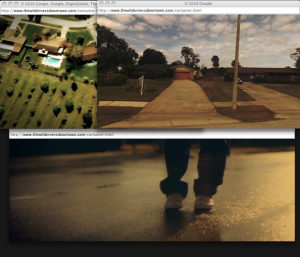The era of digital music distribution and a shift toward reality TV airing on pioneer networks such as MTV has left the traditional model for music videos in limbo. There is no longer a standard approach to production, budgets, distribution or, for that matter, a clearcut means of generating an audience or revenue.
 Today’s music videos may need a new name — and perhaps even a new genre to call home. Innovative artists are leveraging a host of Internet-enabled technologies to break barriers regarding what is possible in short-form visual storytelling. One of the more interesting approaches is taking shape in the form of user control with help from interactive technologies sponsored by Google, Intel and others.
Today’s music videos may need a new name — and perhaps even a new genre to call home. Innovative artists are leveraging a host of Internet-enabled technologies to break barriers regarding what is possible in short-form visual storytelling. One of the more interesting approaches is taking shape in the form of user control with help from interactive technologies sponsored by Google, Intel and others.
In The Wall Street Journal this week, John Jurgensen provides a fascinating snapshot of the last 30 years of music videos and what has led to this change, citing compelling new approaches from directors such as Spike Jonze and Chris Milk. Jurgensen describes several new approaches to what is being called (for the time being, anyway) “interactive films” — including a new Devo video that enables a 360-degree view of various scenes, a director’s chair feature for newcomer Andy Grammer’s video that allows viewers to select scenes, and a video for Swedish pop artist Robyn that copies fans’ tweets and integrates them into a 3D animated collage.
One of the more notable recent examples is The Wilderness Downtown, directed by Chris Milk and set to the Arcade Fire song “We Used to Wait.” Viewers can enter their home addresses, and by using Google’s maps and street visuals, they essentially personalize the experience with “virtual fly-overs” of their childhood homes (for Google, it has become a way of showcasing new functionality of its Chrome browser). Milk has reportedly been working for five months on another secret project funded by Google that puts control of the content in the hands of viewers. It is expected to debut next week.
The article also points out an interesting shift in distribution (and generating ad revenue):
Three out of four major music companies now channel their videos through Vevo, an online video player and distributor launched in late 2009. After years of licensing their videos to sites all over the Web — and seeing measly financial returns — the labels now rely on Vevo to distribute their videos online and sell ads against them. By focusing on slick presentation and sponsored video premieres, the company has pushed ad rates higher. Vevo, whose traffic includes the videos it funnels into sites such as YouTube and Facebook, is the biggest music provider on the Web, attracting 54 million unique viewers last March, up from 37.5 million in the same month last year, according to ComScore Video Metrix.
According to WSJ, the labels are starting to see financial results from the Vevo model, albeit relatively small. For example, a label whose videos accrue 10 million streams via the online player could collect approximately $70,000.
Identifying the next generation of short form video and its audience’s expectations — whether or not in the form of online interactivity — may become vital to new content production and distribution. As consumers continue to adopt tablet PCs and more dynamic media, this may prove to impact more than just music.
Related: Click here to view Chris Milk’s interactive film “The Wilderness Downtown.”
Related: Click here to view another interactive experiment from Milk, “The Johnny Cash Project.”



